A Comprehensive Guide to Poetic Devices and Their Uses
VerifiedAdded on 2019/09/25
|7
|2754
|2735
Homework Assignment
AI Summary
This document provides a comprehensive overview of poetic devices, which are tools used by poets to enhance the meaning and impact of their work. It explains the purpose of these devices in creating rhymes, enriching meaning, and organizing words effectively. The document delves into various poetic devices such as repetition, different types of rhymes (including slant and double rhymes), consonance, alliteration, assonance, simile, metaphor, hyperbole, personification, and imagery. Each device is defined and illustrated with examples, demonstrating how they contribute to a poem's rhythm, tone, mood, and overall message. The text emphasizes the importance of these devices in enabling readers to understand and connect with the poem, enriching the poem with emotion, and making the poem sound beautiful. This is a valuable resource for students studying literature and writing, providing a detailed guide to understanding and utilizing poetic devices to improve their own writing skills.
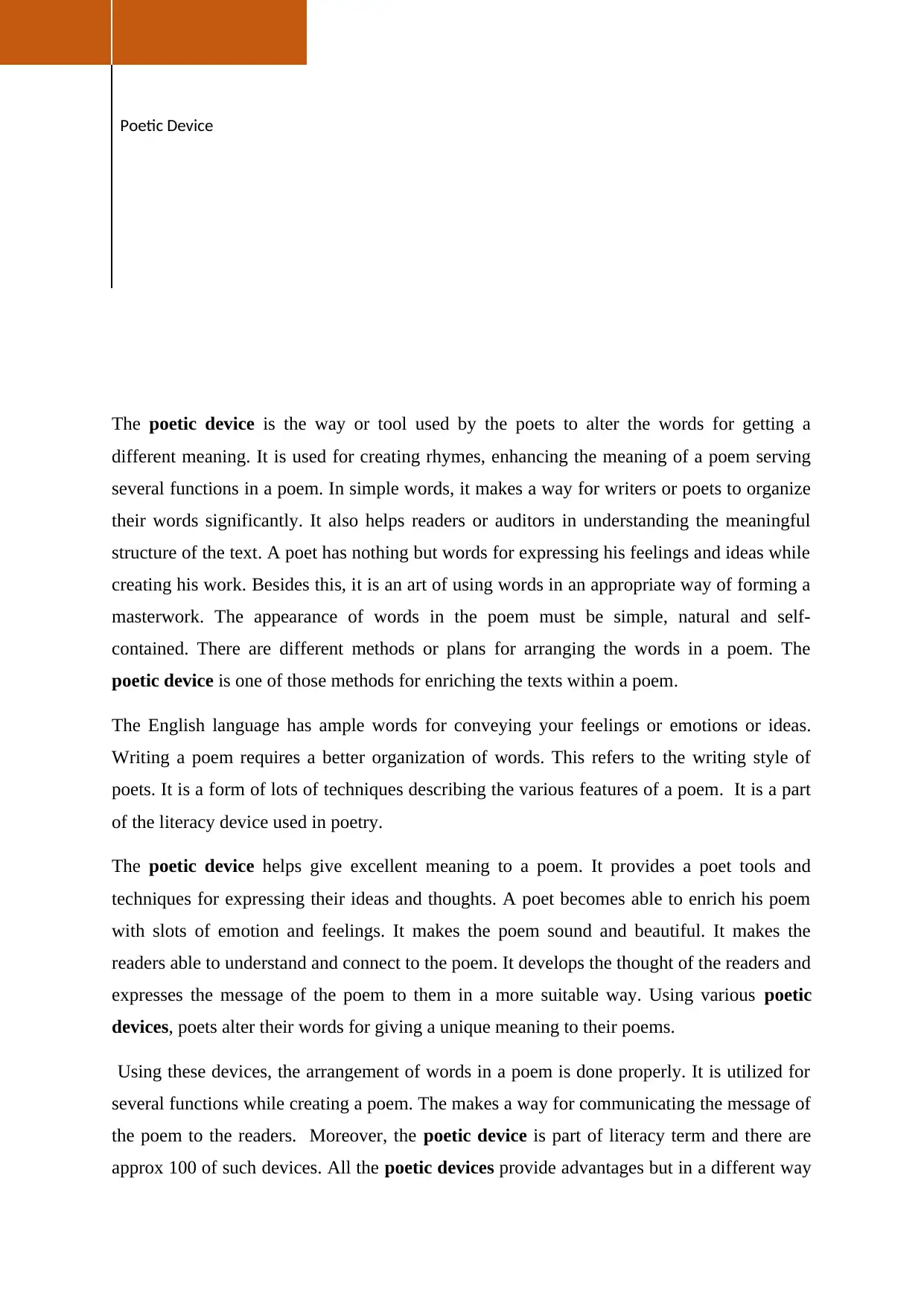
The poetic device is the way or tool used by the poets to alter the words for getting a
different meaning. It is used for creating rhymes, enhancing the meaning of a poem serving
several functions in a poem. In simple words, it makes a way for writers or poets to organize
their words significantly. It also helps readers or auditors in understanding the meaningful
structure of the text. A poet has nothing but words for expressing his feelings and ideas while
creating his work. Besides this, it is an art of using words in an appropriate way of forming a
masterwork. The appearance of words in the poem must be simple, natural and self-
contained. There are different methods or plans for arranging the words in a poem. The
poetic device is one of those methods for enriching the texts within a poem.
The English language has ample words for conveying your feelings or emotions or ideas.
Writing a poem requires a better organization of words. This refers to the writing style of
poets. It is a form of lots of techniques describing the various features of a poem. It is a part
of the literacy device used in poetry.
The poetic device helps give excellent meaning to a poem. It provides a poet tools and
techniques for expressing their ideas and thoughts. A poet becomes able to enrich his poem
with slots of emotion and feelings. It makes the poem sound and beautiful. It makes the
readers able to understand and connect to the poem. It develops the thought of the readers and
expresses the message of the poem to them in a more suitable way. Using various poetic
devices, poets alter their words for giving a unique meaning to their poems.
Using these devices, the arrangement of words in a poem is done properly. It is utilized for
several functions while creating a poem. The makes a way for communicating the message of
the poem to the readers. Moreover, the poetic device is part of literacy term and there are
approx 100 of such devices. All the poetic devices provide advantages but in a different way
Poetic Device
different meaning. It is used for creating rhymes, enhancing the meaning of a poem serving
several functions in a poem. In simple words, it makes a way for writers or poets to organize
their words significantly. It also helps readers or auditors in understanding the meaningful
structure of the text. A poet has nothing but words for expressing his feelings and ideas while
creating his work. Besides this, it is an art of using words in an appropriate way of forming a
masterwork. The appearance of words in the poem must be simple, natural and self-
contained. There are different methods or plans for arranging the words in a poem. The
poetic device is one of those methods for enriching the texts within a poem.
The English language has ample words for conveying your feelings or emotions or ideas.
Writing a poem requires a better organization of words. This refers to the writing style of
poets. It is a form of lots of techniques describing the various features of a poem. It is a part
of the literacy device used in poetry.
The poetic device helps give excellent meaning to a poem. It provides a poet tools and
techniques for expressing their ideas and thoughts. A poet becomes able to enrich his poem
with slots of emotion and feelings. It makes the poem sound and beautiful. It makes the
readers able to understand and connect to the poem. It develops the thought of the readers and
expresses the message of the poem to them in a more suitable way. Using various poetic
devices, poets alter their words for giving a unique meaning to their poems.
Using these devices, the arrangement of words in a poem is done properly. It is utilized for
several functions while creating a poem. The makes a way for communicating the message of
the poem to the readers. Moreover, the poetic device is part of literacy term and there are
approx 100 of such devices. All the poetic devices provide advantages but in a different way
Poetic Device
Paraphrase This Document
Need a fresh take? Get an instant paraphrase of this document with our AI Paraphraser
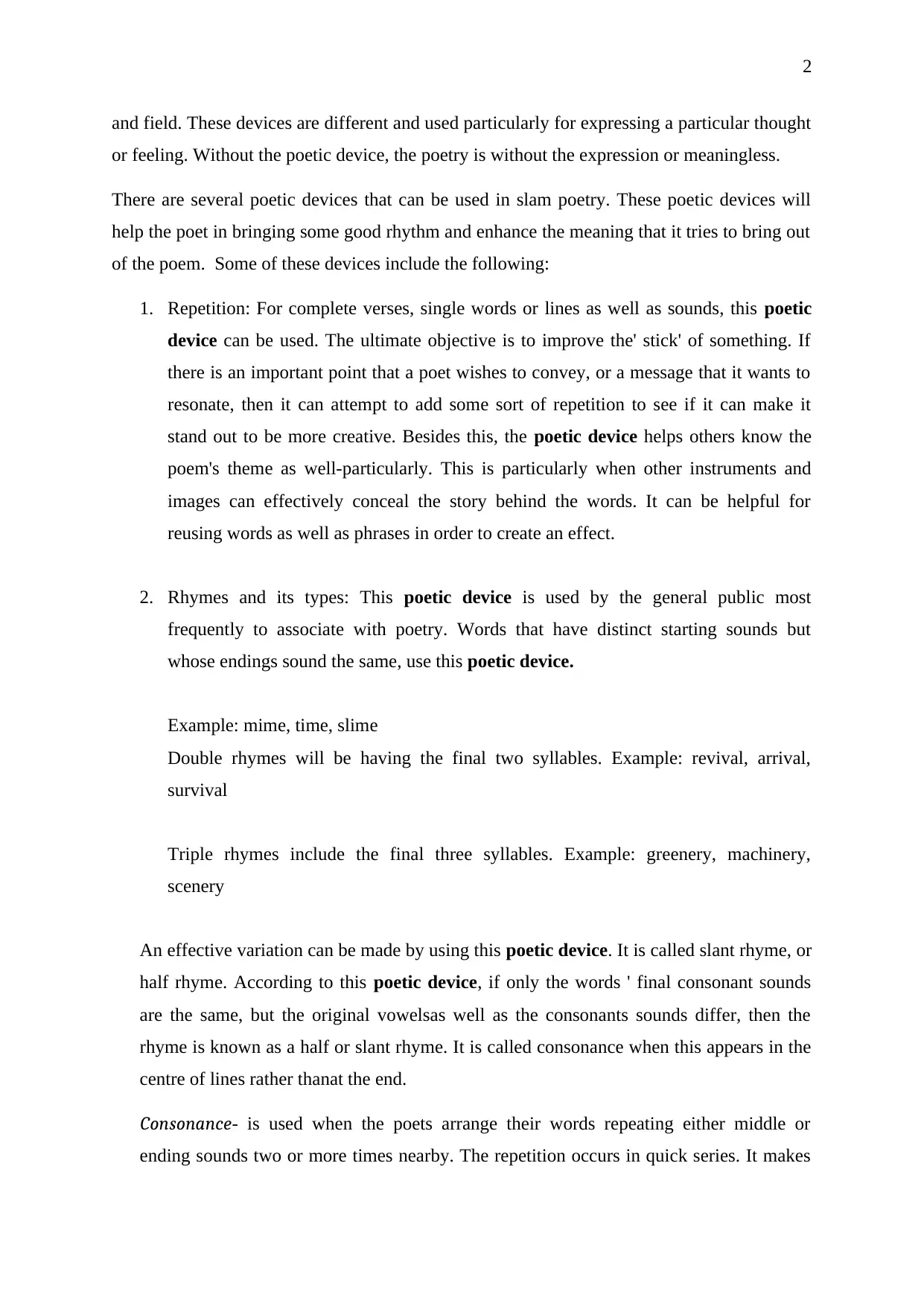
2
and field. These devices are different and used particularly for expressing a particular thought
or feeling. Without the poetic device, the poetry is without the expression or meaningless.
There are several poetic devices that can be used in slam poetry. These poetic devices will
help the poet in bringing some good rhythm and enhance the meaning that it tries to bring out
of the poem. Some of these devices include the following:
1. Repetition: For complete verses, single words or lines as well as sounds, this poetic
device can be used. The ultimate objective is to improve the' stick' of something. If
there is an important point that a poet wishes to convey, or a message that it wants to
resonate, then it can attempt to add some sort of repetition to see if it can make it
stand out to be more creative. Besides this, the poetic device helps others know the
poem's theme as well-particularly. This is particularly when other instruments and
images can effectively conceal the story behind the words. It can be helpful for
reusing words as well as phrases in order to create an effect.
2. Rhymes and its types: This poetic device is used by the general public most
frequently to associate with poetry. Words that have distinct starting sounds but
whose endings sound the same, use this poetic device.
Example: mime, time, slime
Double rhymes will be having the final two syllables. Example: revival, arrival,
survival
Triple rhymes include the final three syllables. Example: greenery, machinery,
scenery
An effective variation can be made by using this poetic device. It is called slant rhyme, or
half rhyme. According to this poetic device, if only the words ' final consonant sounds
are the same, but the original vowelsas well as the consonants sounds differ, then the
rhyme is known as a half or slant rhyme. It is called consonance when this appears in the
centre of lines rather thanat the end.
Consonance- is used when the poets arrange their words repeating either middle or
ending sounds two or more times nearby. The repetition occurs in quick series. It makes
and field. These devices are different and used particularly for expressing a particular thought
or feeling. Without the poetic device, the poetry is without the expression or meaningless.
There are several poetic devices that can be used in slam poetry. These poetic devices will
help the poet in bringing some good rhythm and enhance the meaning that it tries to bring out
of the poem. Some of these devices include the following:
1. Repetition: For complete verses, single words or lines as well as sounds, this poetic
device can be used. The ultimate objective is to improve the' stick' of something. If
there is an important point that a poet wishes to convey, or a message that it wants to
resonate, then it can attempt to add some sort of repetition to see if it can make it
stand out to be more creative. Besides this, the poetic device helps others know the
poem's theme as well-particularly. This is particularly when other instruments and
images can effectively conceal the story behind the words. It can be helpful for
reusing words as well as phrases in order to create an effect.
2. Rhymes and its types: This poetic device is used by the general public most
frequently to associate with poetry. Words that have distinct starting sounds but
whose endings sound the same, use this poetic device.
Example: mime, time, slime
Double rhymes will be having the final two syllables. Example: revival, arrival,
survival
Triple rhymes include the final three syllables. Example: greenery, machinery,
scenery
An effective variation can be made by using this poetic device. It is called slant rhyme, or
half rhyme. According to this poetic device, if only the words ' final consonant sounds
are the same, but the original vowelsas well as the consonants sounds differ, then the
rhyme is known as a half or slant rhyme. It is called consonance when this appears in the
centre of lines rather thanat the end.
Consonance- is used when the poets arrange their words repeating either middle or
ending sounds two or more times nearby. The repetition occurs in quick series. It makes
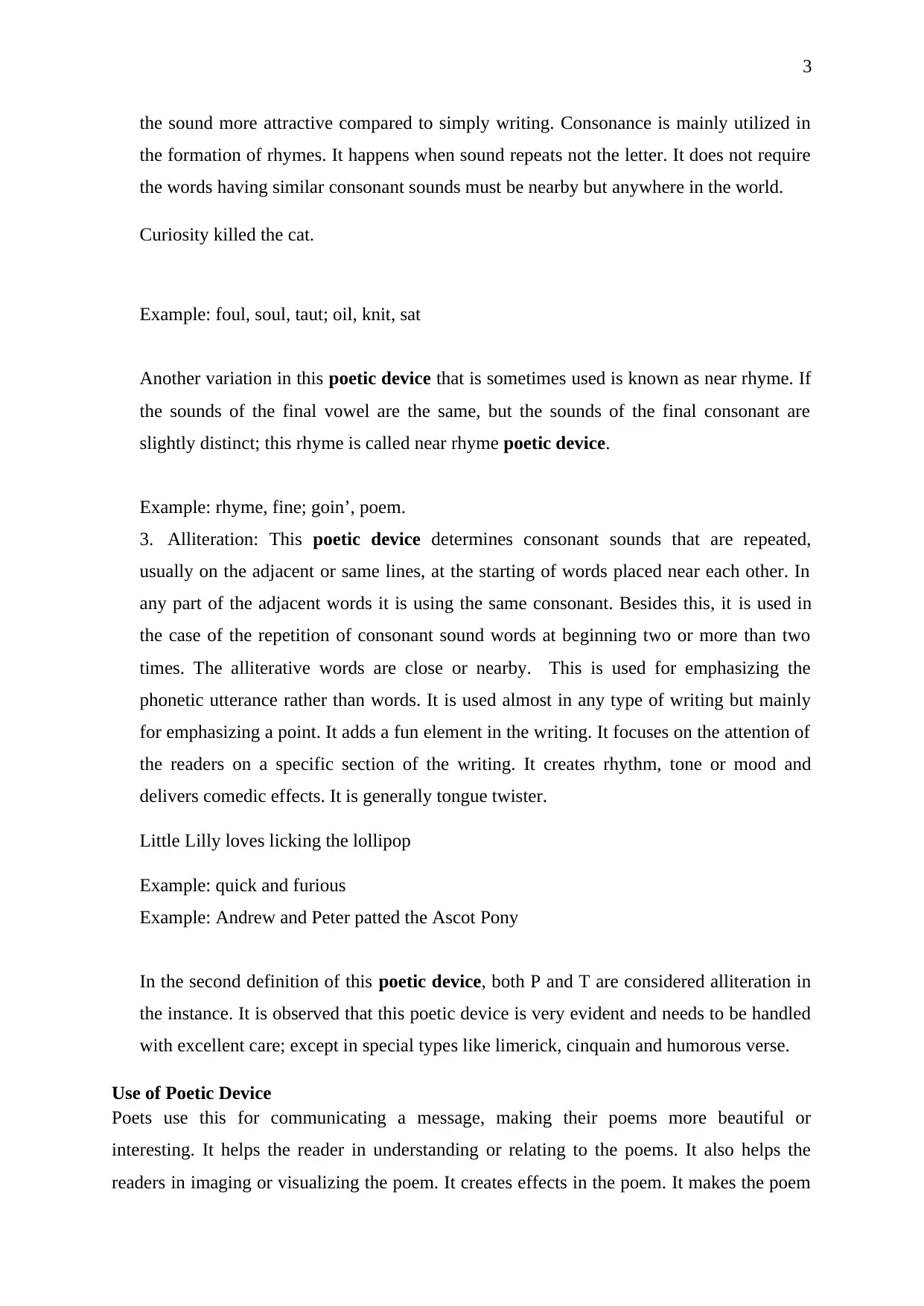
3
the sound more attractive compared to simply writing. Consonance is mainly utilized in
the formation of rhymes. It happens when sound repeats not the letter. It does not require
the words having similar consonant sounds must be nearby but anywhere in the world.
Curiosity killed the cat.
Example: foul, soul, taut; oil, knit, sat
Another variation in this poetic device that is sometimes used is known as near rhyme. If
the sounds of the final vowel are the same, but the sounds of the final consonant are
slightly distinct; this rhyme is called near rhyme poetic device.
Example: rhyme, fine; goin’, poem.
3. Alliteration: This poetic device determines consonant sounds that are repeated,
usually on the adjacent or same lines, at the starting of words placed near each other. In
any part of the adjacent words it is using the same consonant. Besides this, it is used in
the case of the repetition of consonant sound words at beginning two or more than two
times. The alliterative words are close or nearby. This is used for emphasizing the
phonetic utterance rather than words. It is used almost in any type of writing but mainly
for emphasizing a point. It adds a fun element in the writing. It focuses on the attention of
the readers on a specific section of the writing. It creates rhythm, tone or mood and
delivers comedic effects. It is generally tongue twister.
Little Lilly loves licking the lollipop
Example: quick and furious
Example: Andrew and Peter patted the Ascot Pony
In the second definition of this poetic device, both P and T are considered alliteration in
the instance. It is observed that this poetic device is very evident and needs to be handled
with excellent care; except in special types like limerick, cinquain and humorous verse.
Use of Poetic Device
Poets use this for communicating a message, making their poems more beautiful or
interesting. It helps the reader in understanding or relating to the poems. It also helps the
readers in imaging or visualizing the poem. It creates effects in the poem. It makes the poem
the sound more attractive compared to simply writing. Consonance is mainly utilized in
the formation of rhymes. It happens when sound repeats not the letter. It does not require
the words having similar consonant sounds must be nearby but anywhere in the world.
Curiosity killed the cat.
Example: foul, soul, taut; oil, knit, sat
Another variation in this poetic device that is sometimes used is known as near rhyme. If
the sounds of the final vowel are the same, but the sounds of the final consonant are
slightly distinct; this rhyme is called near rhyme poetic device.
Example: rhyme, fine; goin’, poem.
3. Alliteration: This poetic device determines consonant sounds that are repeated,
usually on the adjacent or same lines, at the starting of words placed near each other. In
any part of the adjacent words it is using the same consonant. Besides this, it is used in
the case of the repetition of consonant sound words at beginning two or more than two
times. The alliterative words are close or nearby. This is used for emphasizing the
phonetic utterance rather than words. It is used almost in any type of writing but mainly
for emphasizing a point. It adds a fun element in the writing. It focuses on the attention of
the readers on a specific section of the writing. It creates rhythm, tone or mood and
delivers comedic effects. It is generally tongue twister.
Little Lilly loves licking the lollipop
Example: quick and furious
Example: Andrew and Peter patted the Ascot Pony
In the second definition of this poetic device, both P and T are considered alliteration in
the instance. It is observed that this poetic device is very evident and needs to be handled
with excellent care; except in special types like limerick, cinquain and humorous verse.
Use of Poetic Device
Poets use this for communicating a message, making their poems more beautiful or
interesting. It helps the reader in understanding or relating to the poems. It also helps the
readers in imaging or visualizing the poem. It creates effects in the poem. It makes the poem
⊘ This is a preview!⊘
Do you want full access?
Subscribe today to unlock all pages.

Trusted by 1+ million students worldwide
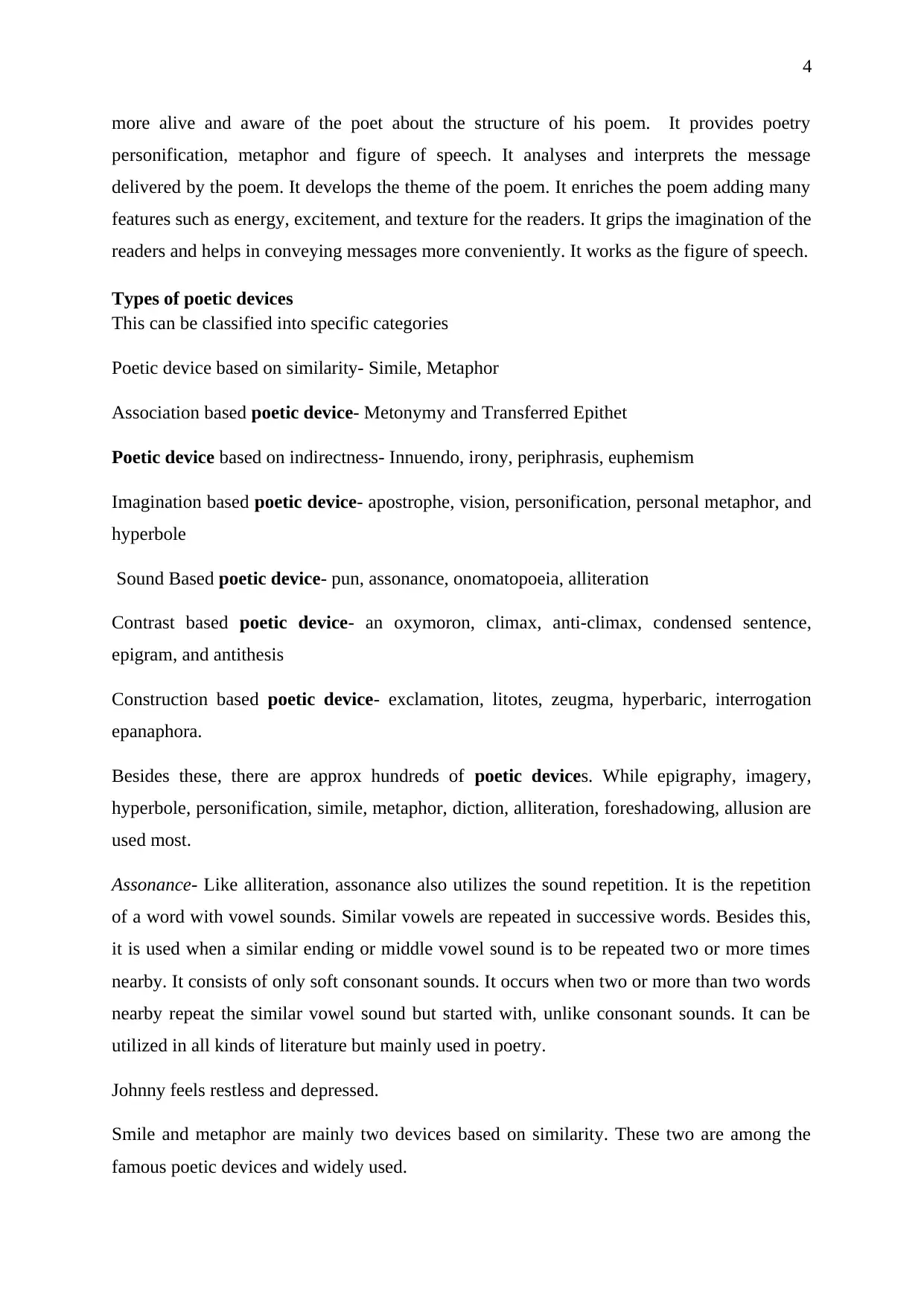
4
more alive and aware of the poet about the structure of his poem. It provides poetry
personification, metaphor and figure of speech. It analyses and interprets the message
delivered by the poem. It develops the theme of the poem. It enriches the poem adding many
features such as energy, excitement, and texture for the readers. It grips the imagination of the
readers and helps in conveying messages more conveniently. It works as the figure of speech.
Types of poetic devices
This can be classified into specific categories
Poetic device based on similarity- Simile, Metaphor
Association based poetic device- Metonymy and Transferred Epithet
Poetic device based on indirectness- Innuendo, irony, periphrasis, euphemism
Imagination based poetic device- apostrophe, vision, personification, personal metaphor, and
hyperbole
Sound Based poetic device- pun, assonance, onomatopoeia, alliteration
Contrast based poetic device- an oxymoron, climax, anti-climax, condensed sentence,
epigram, and antithesis
Construction based poetic device- exclamation, litotes, zeugma, hyperbaric, interrogation
epanaphora.
Besides these, there are approx hundreds of poetic devices. While epigraphy, imagery,
hyperbole, personification, simile, metaphor, diction, alliteration, foreshadowing, allusion are
used most.
Assonance- Like alliteration, assonance also utilizes the sound repetition. It is the repetition
of a word with vowel sounds. Similar vowels are repeated in successive words. Besides this,
it is used when a similar ending or middle vowel sound is to be repeated two or more times
nearby. It consists of only soft consonant sounds. It occurs when two or more than two words
nearby repeat the similar vowel sound but started with, unlike consonant sounds. It can be
utilized in all kinds of literature but mainly used in poetry.
Johnny feels restless and depressed.
Smile and metaphor are mainly two devices based on similarity. These two are among the
famous poetic devices and widely used.
more alive and aware of the poet about the structure of his poem. It provides poetry
personification, metaphor and figure of speech. It analyses and interprets the message
delivered by the poem. It develops the theme of the poem. It enriches the poem adding many
features such as energy, excitement, and texture for the readers. It grips the imagination of the
readers and helps in conveying messages more conveniently. It works as the figure of speech.
Types of poetic devices
This can be classified into specific categories
Poetic device based on similarity- Simile, Metaphor
Association based poetic device- Metonymy and Transferred Epithet
Poetic device based on indirectness- Innuendo, irony, periphrasis, euphemism
Imagination based poetic device- apostrophe, vision, personification, personal metaphor, and
hyperbole
Sound Based poetic device- pun, assonance, onomatopoeia, alliteration
Contrast based poetic device- an oxymoron, climax, anti-climax, condensed sentence,
epigram, and antithesis
Construction based poetic device- exclamation, litotes, zeugma, hyperbaric, interrogation
epanaphora.
Besides these, there are approx hundreds of poetic devices. While epigraphy, imagery,
hyperbole, personification, simile, metaphor, diction, alliteration, foreshadowing, allusion are
used most.
Assonance- Like alliteration, assonance also utilizes the sound repetition. It is the repetition
of a word with vowel sounds. Similar vowels are repeated in successive words. Besides this,
it is used when a similar ending or middle vowel sound is to be repeated two or more times
nearby. It consists of only soft consonant sounds. It occurs when two or more than two words
nearby repeat the similar vowel sound but started with, unlike consonant sounds. It can be
utilized in all kinds of literature but mainly used in poetry.
Johnny feels restless and depressed.
Smile and metaphor are mainly two devices based on similarity. These two are among the
famous poetic devices and widely used.
Paraphrase This Document
Need a fresh take? Get an instant paraphrase of this document with our AI Paraphraser
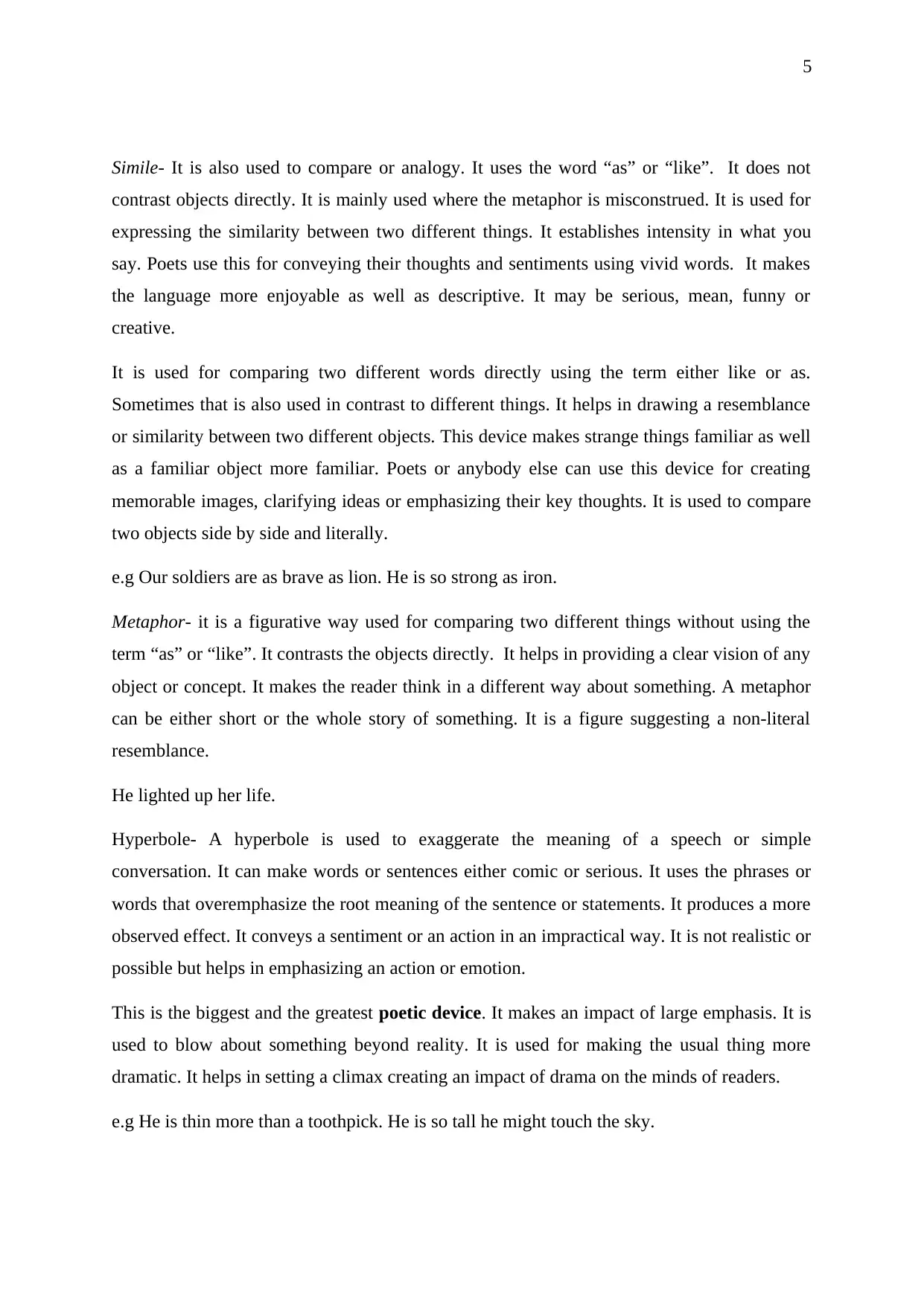
5
Simile- It is also used to compare or analogy. It uses the word “as” or “like”. It does not
contrast objects directly. It is mainly used where the metaphor is misconstrued. It is used for
expressing the similarity between two different things. It establishes intensity in what you
say. Poets use this for conveying their thoughts and sentiments using vivid words. It makes
the language more enjoyable as well as descriptive. It may be serious, mean, funny or
creative.
It is used for comparing two different words directly using the term either like or as.
Sometimes that is also used in contrast to different things. It helps in drawing a resemblance
or similarity between two different objects. This device makes strange things familiar as well
as a familiar object more familiar. Poets or anybody else can use this device for creating
memorable images, clarifying ideas or emphasizing their key thoughts. It is used to compare
two objects side by side and literally.
e.g Our soldiers are as brave as lion. He is so strong as iron.
Metaphor- it is a figurative way used for comparing two different things without using the
term “as” or “like”. It contrasts the objects directly. It helps in providing a clear vision of any
object or concept. It makes the reader think in a different way about something. A metaphor
can be either short or the whole story of something. It is a figure suggesting a non-literal
resemblance.
He lighted up her life.
Hyperbole- A hyperbole is used to exaggerate the meaning of a speech or simple
conversation. It can make words or sentences either comic or serious. It uses the phrases or
words that overemphasize the root meaning of the sentence or statements. It produces a more
observed effect. It conveys a sentiment or an action in an impractical way. It is not realistic or
possible but helps in emphasizing an action or emotion.
This is the biggest and the greatest poetic device. It makes an impact of large emphasis. It is
used to blow about something beyond reality. It is used for making the usual thing more
dramatic. It helps in setting a climax creating an impact of drama on the minds of readers.
e.g He is thin more than a toothpick. He is so tall he might touch the sky.
Simile- It is also used to compare or analogy. It uses the word “as” or “like”. It does not
contrast objects directly. It is mainly used where the metaphor is misconstrued. It is used for
expressing the similarity between two different things. It establishes intensity in what you
say. Poets use this for conveying their thoughts and sentiments using vivid words. It makes
the language more enjoyable as well as descriptive. It may be serious, mean, funny or
creative.
It is used for comparing two different words directly using the term either like or as.
Sometimes that is also used in contrast to different things. It helps in drawing a resemblance
or similarity between two different objects. This device makes strange things familiar as well
as a familiar object more familiar. Poets or anybody else can use this device for creating
memorable images, clarifying ideas or emphasizing their key thoughts. It is used to compare
two objects side by side and literally.
e.g Our soldiers are as brave as lion. He is so strong as iron.
Metaphor- it is a figurative way used for comparing two different things without using the
term “as” or “like”. It contrasts the objects directly. It helps in providing a clear vision of any
object or concept. It makes the reader think in a different way about something. A metaphor
can be either short or the whole story of something. It is a figure suggesting a non-literal
resemblance.
He lighted up her life.
Hyperbole- A hyperbole is used to exaggerate the meaning of a speech or simple
conversation. It can make words or sentences either comic or serious. It uses the phrases or
words that overemphasize the root meaning of the sentence or statements. It produces a more
observed effect. It conveys a sentiment or an action in an impractical way. It is not realistic or
possible but helps in emphasizing an action or emotion.
This is the biggest and the greatest poetic device. It makes an impact of large emphasis. It is
used to blow about something beyond reality. It is used for making the usual thing more
dramatic. It helps in setting a climax creating an impact of drama on the minds of readers.
e.g He is thin more than a toothpick. He is so tall he might touch the sky.

6
Personification- it is used for characterizing non-human things with human features. In this
method, an abstract quality is represented in the human figure by the poet. In addition to this,
it is used in the case of describing a non-living thing with the features of human being or
events. Sometimes, it is also used for animals as animal lovers consider that they are not very
diverse from human beings. It brings inanimate objects to life for better explaining them. It
helps the author in writing more brilliantly making readers healthily recognize the animal or
object.
My laptop is not supporting me.
See my painting; they are beautiful, aren't they?
There are over a hundred devices that are used in poetry. Besides the above-mentioned
devices, Imagery, stanza, irony, and rhymes schemes are some other commonly used poetic
devices.
Imagery – in this poetic device, images are created using words. It refers to the caliber of
forming mental pictures of events or things. It helps in describing things visually. It helps the
readers in understanding the mood and emotions of the character. A single line can be
sufficient for forming a picture. Sometimes, a single line with imagery can beat a whole
paragraph with no expressive device.
It is one of the strongest devices used in poetry. It helps in creating mental images using the
phrases or words engaging human senses. It made readers able to visualizing the writing of
the author realistically or practically. It is used when a poet tries to describe such objects that
appeal to at least one of the five senses.
She felt that the moon was waving hello.
Foreshadowing- this is such an act that provides unclear advance indications. It indicates that
is going to happen. It indirectly tells about the things which are to be occurring later in the
poem or story. It can cause expectation or tension.
Stanza- it is of two or more than two lines mainly with four lines of a poem. It makes one of
the parts of the poem. All the stanzas of a poem are of the same length following the same
rhymes or meter pattern. In addition, it is a single and related portion of a particular poem
having two or more lines. It refers to a combination of lines forming one specific section in
Personification- it is used for characterizing non-human things with human features. In this
method, an abstract quality is represented in the human figure by the poet. In addition to this,
it is used in the case of describing a non-living thing with the features of human being or
events. Sometimes, it is also used for animals as animal lovers consider that they are not very
diverse from human beings. It brings inanimate objects to life for better explaining them. It
helps the author in writing more brilliantly making readers healthily recognize the animal or
object.
My laptop is not supporting me.
See my painting; they are beautiful, aren't they?
There are over a hundred devices that are used in poetry. Besides the above-mentioned
devices, Imagery, stanza, irony, and rhymes schemes are some other commonly used poetic
devices.
Imagery – in this poetic device, images are created using words. It refers to the caliber of
forming mental pictures of events or things. It helps in describing things visually. It helps the
readers in understanding the mood and emotions of the character. A single line can be
sufficient for forming a picture. Sometimes, a single line with imagery can beat a whole
paragraph with no expressive device.
It is one of the strongest devices used in poetry. It helps in creating mental images using the
phrases or words engaging human senses. It made readers able to visualizing the writing of
the author realistically or practically. It is used when a poet tries to describe such objects that
appeal to at least one of the five senses.
She felt that the moon was waving hello.
Foreshadowing- this is such an act that provides unclear advance indications. It indicates that
is going to happen. It indirectly tells about the things which are to be occurring later in the
poem or story. It can cause expectation or tension.
Stanza- it is of two or more than two lines mainly with four lines of a poem. It makes one of
the parts of the poem. All the stanzas of a poem are of the same length following the same
rhymes or meter pattern. In addition, it is a single and related portion of a particular poem
having two or more lines. It refers to a combination of lines forming one specific section in
⊘ This is a preview!⊘
Do you want full access?
Subscribe today to unlock all pages.

Trusted by 1+ million students worldwide
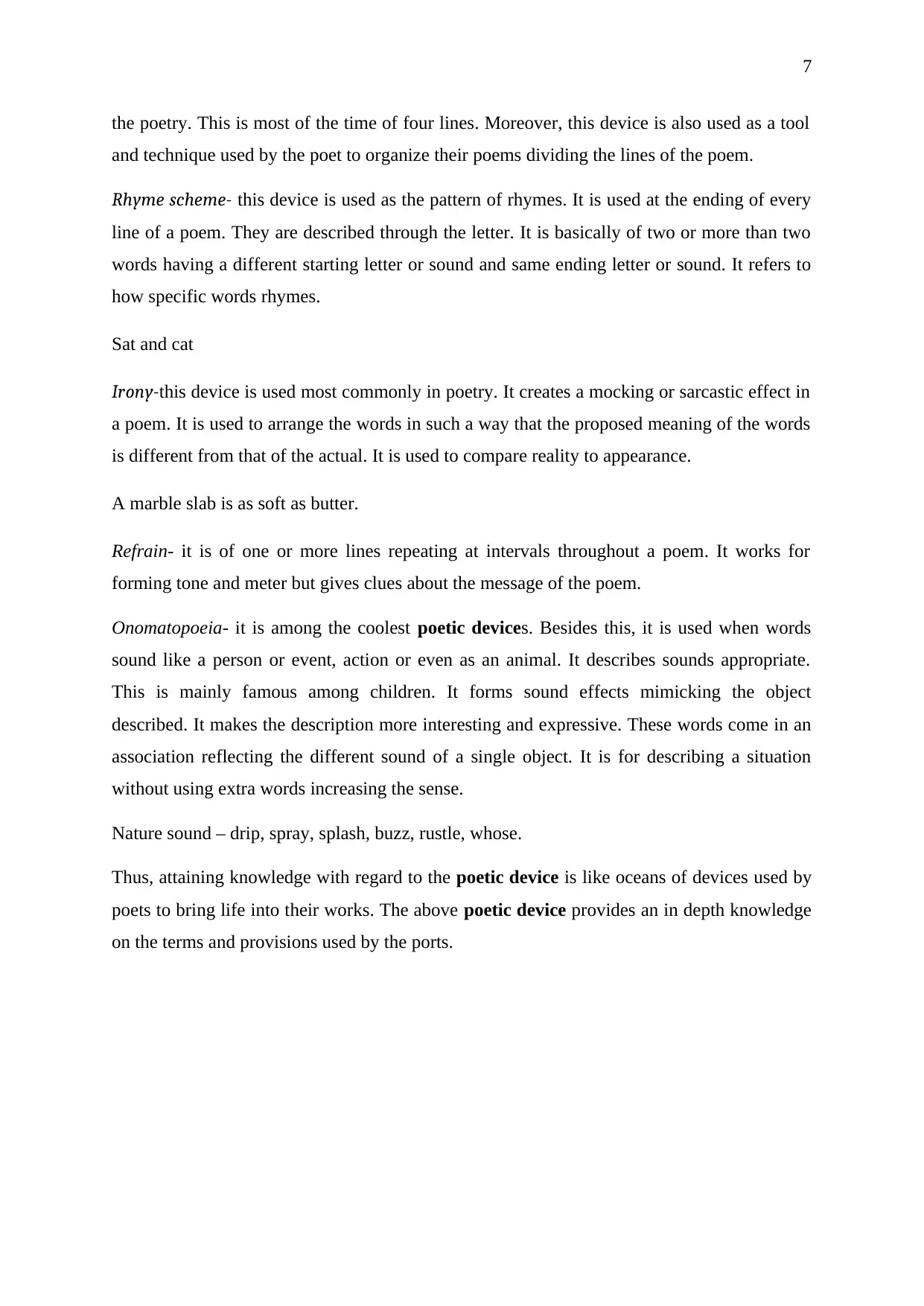
7
the poetry. This is most of the time of four lines. Moreover, this device is also used as a tool
and technique used by the poet to organize their poems dividing the lines of the poem.
Rhyme scheme- this device is used as the pattern of rhymes. It is used at the ending of every
line of a poem. They are described through the letter. It is basically of two or more than two
words having a different starting letter or sound and same ending letter or sound. It refers to
how specific words rhymes.
Sat and cat
Irony-this device is used most commonly in poetry. It creates a mocking or sarcastic effect in
a poem. It is used to arrange the words in such a way that the proposed meaning of the words
is different from that of the actual. It is used to compare reality to appearance.
A marble slab is as soft as butter.
Refrain- it is of one or more lines repeating at intervals throughout a poem. It works for
forming tone and meter but gives clues about the message of the poem.
Onomatopoeia- it is among the coolest poetic devices. Besides this, it is used when words
sound like a person or event, action or even as an animal. It describes sounds appropriate.
This is mainly famous among children. It forms sound effects mimicking the object
described. It makes the description more interesting and expressive. These words come in an
association reflecting the different sound of a single object. It is for describing a situation
without using extra words increasing the sense.
Nature sound – drip, spray, splash, buzz, rustle, whose.
Thus, attaining knowledge with regard to the poetic device is like oceans of devices used by
poets to bring life into their works. The above poetic device provides an in depth knowledge
on the terms and provisions used by the ports.
the poetry. This is most of the time of four lines. Moreover, this device is also used as a tool
and technique used by the poet to organize their poems dividing the lines of the poem.
Rhyme scheme- this device is used as the pattern of rhymes. It is used at the ending of every
line of a poem. They are described through the letter. It is basically of two or more than two
words having a different starting letter or sound and same ending letter or sound. It refers to
how specific words rhymes.
Sat and cat
Irony-this device is used most commonly in poetry. It creates a mocking or sarcastic effect in
a poem. It is used to arrange the words in such a way that the proposed meaning of the words
is different from that of the actual. It is used to compare reality to appearance.
A marble slab is as soft as butter.
Refrain- it is of one or more lines repeating at intervals throughout a poem. It works for
forming tone and meter but gives clues about the message of the poem.
Onomatopoeia- it is among the coolest poetic devices. Besides this, it is used when words
sound like a person or event, action or even as an animal. It describes sounds appropriate.
This is mainly famous among children. It forms sound effects mimicking the object
described. It makes the description more interesting and expressive. These words come in an
association reflecting the different sound of a single object. It is for describing a situation
without using extra words increasing the sense.
Nature sound – drip, spray, splash, buzz, rustle, whose.
Thus, attaining knowledge with regard to the poetic device is like oceans of devices used by
poets to bring life into their works. The above poetic device provides an in depth knowledge
on the terms and provisions used by the ports.
1 out of 7
Related Documents
Your All-in-One AI-Powered Toolkit for Academic Success.
+13062052269
info@desklib.com
Available 24*7 on WhatsApp / Email
![[object Object]](/_next/static/media/star-bottom.7253800d.svg)
Unlock your academic potential
Copyright © 2020–2025 A2Z Services. All Rights Reserved. Developed and managed by ZUCOL.





